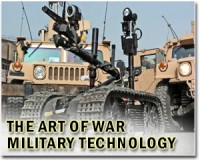| . |  |
. |
Eglin AFB FL (AFNS) Feb 11, 2010 Air Force Research Laboratory awarded Imagination Engines, Inc., a Phase II Small Business Innovation Research contract to develop advanced algorithms for mobile autonomous robots. The Air Force needs creative terrain-sensing and multivalued behavior-fusion algorithms for these robots due to the high uncertainty and complexity of battlefield environments. Mobile autonomous robots must employ not only a variety of locomotion techniques in order to navigate different terrains, but an assortment of creative behaviors to accomplish their objectives. The foundation of this SBIR technology is a scientific principle at least as important and fundamental as jet propulsion or nuclear energy. Specifically, it hinges on the premise that injecting critical noise levels into a system of brainstorming neural networks produces new ideas and strategies. This so-called "creativity machine paradigm" vastly outperforms genetic algorithms running on supercomputers, carrying out multidimensional optimization and invention on computational platforms common to most homes and offices. Described as the artificial intelligence domain's best bet for creating human- to transhuman-level intelligence in machines, this technology could potentially permeate all aspects of AF activities and operations, from materials discovery and autonomous weaponry to logistical planning and sensor integration. IEI has pioneered the development of neural control systems capable of brilliant adaptation and improvisational creativity that may be used to govern truly autonomous weapons systems. The technology also enables semiautonomous military systems to perform in the event of communications loss, or to temporarily gain a clear advantage by operating outside an adversary's largely human-based OODA [observe, orient, decide, and act] loop. The technology further allows vast neural systems to automatically knit themselves into the equivalent of human brain pathways, facilitating unprecedented levels of sensor integration and unmatched machine-vision-based anomaly detection for battle damage assessment and classification (e.g., automatic target recognition).
Share This Article With Planet Earth
Related Links USAF Research Laboratory The latest in Military Technology for the 21st century at SpaceWar.com
 Britain says bomb tests on pigs saved lives in war zones
Britain says bomb tests on pigs saved lives in war zonesLondon (AFP) Feb 10, 2010 Britain has defended the use of more than 100 pigs in military explosives tests in the past five years, saying the experiments had saved lives in Afghanistan and Iraq. The swine were used in bomb tests at a government military research laboratory between 2005 and 2009, but defence officials insisted Tuesday the experiments had helped improve treatment of blast injuries. "This research ha ... read more |
|
| The content herein, unless otherwise known to be public domain, are Copyright 1995-2010 - SpaceDaily. AFP and UPI Wire Stories are copyright Agence France-Presse and United Press International. ESA Portal Reports are copyright European Space Agency. All NASA sourced material is public domain. Additional copyrights may apply in whole or part to other bona fide parties. Advertising does not imply endorsement,agreement or approval of any opinions, statements or information provided by SpaceDaily on any Web page published or hosted by SpaceDaily. Privacy Statement |